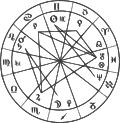Planets in astrology
Planets in astrology have a meaning different from the ancient astronomical understanding of what a planet is. Before the age of telescopes, the night sky was thought to consist of two very similar components: fixed stars, which remained motionless in relation to each other, and "wandering stars" (Ancient Greek: ἀστέρες πλανῆται asteres planetai), which moved relative to the fixed stars over the course of the year.
| Astrology |
|---|
 |
| Background |
| Traditions |
| Branches |
To the Greeks and the other earliest astronomers, this group consisted of the five planets visible to the naked eye and excluded Earth. Although strictly, the term planet applied only to those five objects, the term was latterly broadened, particularly in the Middle Ages, to include the Sun and the Moon (sometimes referred to as "Lights",[1]) making a total of seven planets. Astrologers retain this definition today.
To ancient astrologers, the planets represented the will of the gods and their direct influence upon human affairs. To modern astrologers, the planets can represent basic drives or urges in the unconscious,[2] or energy flow regulators representing dimensions of experience.[3] They express themselves with different qualities in the twelve signs of the zodiac and in the twelve houses. The planets are also related to each other in the form of aspects.
Modern astrologers differ on the source of the correlations between planetary positions and configurations, on the one hand, and characteristics and destinies of the natives, on the other. Hone writes that the planets exert it directly through gravitation or another, unknown influence.[4] Others hold that the planets have no direct influence in themselves, but are mirrors of basic organizing principles in the universe. In other words, the basic patterns of the universe repeat themselves everywhere, in fractal-like fashion, and "as above, so below".[5] Therefore, the patterns that the planets make in the sky reflect the ebb and flow of basic human impulses. The planets are also associated, especially in the Chinese tradition, with the basic forces of nature.
Listed below are the specific meanings and domains associated with the astrological planets since ancient times, with the main focus on the Western astrological tradition. The planets in Hindu astrology are known as the Navagraha (literally "nine planets"), with the addition of two shadow bodies Rahu and Ketu. In Chinese astrology, the planets are associated with the life forces of Yin and yang and the five elements, which play an important role in the Chinese form of geomancy known as Feng Shui. Astrologers differ on the signs associated with each planet's exaltation.
Planetary symbolism
This table shows the astrological planets (as distinct from the astronomical) and the Greek and Roman deities associated with them. In most cases, the English name for planets derives from the name of a Roman god or goddess. Also of interest is the conflation of the Roman god with a similar Greek god. In some cases, it is the same deity with two different names.
| Planet | Symbol | Roman deity | Greek God | Babylonian God | Armenian God | Hindu God | Connection | Meaning (European) | Meaning (Vedic) |
|---|---|---|---|---|---|---|---|---|---|
| Sun | Sol |
Ἥλιος (Helios) Ἀπόλλων (Apollo) |
𒀭𒌓 (Shamash) | Արև (Arev) | सूर्य (Surya) | ancient | God of Prophecy and Solar Incarnation Helios means "sun." |
The Sun God. Associated with ego, sense of purpose, and vitality. Son of Aditi and Kashyap; Surya means "the supreme light." | |
| Moon | Luna Diana |
Σελήνη (Selene) Ἄρτεμις (Artemis) |
𒂗𒍪 (Sin) | Լուսին (Lusin) | चंद्र (Chandra) | ancient | Goddess of Hunting and Lunar Incarnation Selene means "moon." |
The Moon God. Associated with emotions, the mother, and motherly instincts. Chandra means "shining." | |
| Mercury | Mercury | ʽἙρμῆς (Hermes) | 𒀭𒀝 (Nabu) | Լուծ (Luć) | बुध (Budha) | ancient | God of messengers, travel, and/or commerce. | A planet god known for his preserving and protecting nature to mankind and manhood. Associated with communication, wit, and cleverness.[6] | |
| Venus | Venus | Ἀφροδίτη (Aphrodite) Κύπριδα (Cypris) Κυθέρεια (Cytherea) |
𒀭𒈹 (Inanna) | Եղջերու (Yełjeru) | शुक्र (Shukra) | ancient | Goddess of romance and lust; Venus means "love" and/or "sexual desire."[7] | The mentor of Asuras. Associated with fertility, beauty, and enthusiasm. Always helped demons in the war against gods; Shukra means "clear, pure, brightness, or clearness." | |
| Mars | Mars | Ἀρης (Ares) | 𒀭𒄊𒀕𒃲 (Nergal) | Ծկրավորի (Ćkravori) | मंगल (Mangala) | ancient | God of War | Son of Earth. This planet is associated with auspicious occasions . Also associated with strength, aggression and anger. | |
| Ceres | Ceres | Δημήτηρ (Demeter) | Արգավանա (Argavana) | Shakti (Shakti) | modern | Goddess of the seasons; Demeter means "Daughter of the Harvest."[8][9] | The Great Divine Mother in Hinduism; Shakti means "power, strength, might, energy, or capacity." | ||
| Jupiter | Jupiter Jove |
Δίας (Dias) | 𒀭𒀫𒌓 (Marduk) | Փառազնոտ (Þaŕaznot) | गुरु (Guru) बृहस्पती (Brihaspati) |
ancient | Leader, King and Father of the Olympian Gods; Jupiter means "Jovial King" and/or "Father of Thunder." | Mentor and teacher of gods. Always helped gods in war against demons. Guru means "teacher" or "priest." Brihaspati means "lord of prayer or devotion."[10] Associated with luck and expansion. | |
| Saturn | Saturn | Κρόνος (Cronus) | 𒀭𒊩𒌆𒅁 (Ninurta) | Արտախույր (Artaxuyr) | शनि (Shani) | ancient | God of Agriculture and the Father of Jupiter. Leader and ruler of the Titans; Saturn means "God of Seeds", "Father of the Harvest", and/or "Father Time." |
God of Karma and Justice; Gives ones consequences for their deeds. This planet is associated with status, equitable punishment, wisdom, ambition, patience, honor, toughness, but with pessimism, hardships, and fatalism. | |
| Uranus | Caelus | Ουρανός (Ouranos) | 𒀭𒀭 (Anu) | Երկնակ (Yerknak) | अरुण (Aruna) | modern | God of the Sky, Father of Saturn and Grandfather of Jupiter; "Uranus" and "Caelus" both mean "Sky" and/or "Father Sky." | Charioteer of Sun and half brother of A mythological snake king Vasuki in Indian Puranas. Vasuki means "of divine being." This planet is associated with originality, eccentricity, and sudden changes.[11] | |
| Neptune | Neptune | Ποσειδῶν (Poseidon) | Մոսմոռակ (Mosmoŕak) | वरुण (Varuna) | modern | God of the Sea | God of rain in Indian mythology; Varuna means "God of the sea." This planet is associated with dreams, illusions, and psychic receptivity, but sometimes with vagueness and uncertainty as well.[12] | ||
| Pluto | Pluto | Πλούτων (Plouton) Ἅδης (Hades) |
Հեռակ (Heŕak) | यम (Yama) | modern | God of the Underworld and Death; Hades means "the unseen" and Pluto means "wealth." | God of Death and Rebirth. Associated with subconscious forces, ruling all that is 'below the surface' (Hell) | ||
Daily motion
| Planet | Average speed (geocentric) [13] |
Highest speed (geocentric) [13] |
Lowest speed (geocentric) [14] |
|---|---|---|---|
| Sun | 00°59'08" | 01°03'00" | 00°57'10" |
| Moon | 13°10'35" | 16°30'00" | 11°45'36" |
| Mercury | 01°23'00" | 02°25'00" | −01°30'00" |
| Venus | 01°12'00" | 01°22'00" | −00°41'12" |
| Mars | 00°31'27" | 00°52'00" | −00°26'12" |
| Ceres | 00°12'40" | 00°30'00" | −00°16'00" |
| Jupiter | 00°04'59" | 00°15'40" | −00°08'50" |
| Saturn | 00°02'01" | 00°08'48" | −00°05'30" |
| Uranus | 00°00'42" | 00°04'00" | −00°02'40" |
| Neptune | 00°00'24" | 00°02'25" | −00°01'45" |
| Pluto | 00°00'15" | 00°02'30" | −00°01'48" |
| Pallas | 00°12'20" | 00°40'30" | −00°22'30" |
| Juno | 00°14'15" | 00°39'00" | −00°18'00" |
| Vesta | 00°16'15" | 00°36'00" | −00°17'32" |
| Chiron | 00°02'00" | 00°10'00" | −00°06'00" |
History
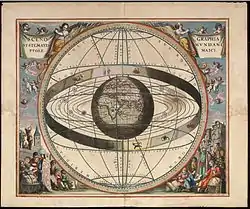
Treatises on the Ptolemaic planets and their influence on people born "under their reign" appear in block book form, so-called "planet books" or Planetenbücher. This genre is attested in numerous manuscripts beginning in the mid 15th century in the Alemannic German area;[15][16][17][18][19] it remained popular throughout the German Renaissance, exerting great iconographical influence far into the 17th century.
These books usually list a male and a female Titan with each planet, Cronus and Rhea with Saturn, Eurymedon and Themis with Jupiter, probably Crius and Dione with Mars, Hyperion and Theia with Sun, Atlas and Phoebe with Moon, Coeus and Metis with Mercury, and Oceanus and Tethys with Venus.[20][21] These planetary correspondences are linked to the ancient Greek myth of Eurynome as noted by Robert Graves.[22]
The qualities inherited from the planets by their children are as follows:
Classical planets
The seven classical planets are those easily seen with the naked eye, and were thus known to ancient astrologers. They are the Moon, Mercury, Venus, The Sun, Mars, Jupiter and Saturn. Sometimes, the Sun and Moon were referred to as "the lights" or the "luminaries". Vesta and Uranus can also just be seen with the naked eye, though no ancient culture appears to have taken note of them. The Classical planets fit neatly into the theories of Aristotle and Ptolemy, they each are part of a Celestial sphere. The order of the Classical planets is determined by the rate of speed. The Moon moves the fastest and so she is considered to form the first celestial sphere above earth. Everything below the moon is part of the sublunary sphere. Mercury moves the second fastest and so he rules the next highest sphere. Next is Venus, who takes about 260 days to revolve around the Sun. Following that is the Sun, then Mars, Jupiter and Saturn.

The astrological descriptions attached to the seven classical planets have been preserved since ancient times. Astrologers call the seven classical planets "the seven personal and social planets", because they are said to represent the basic human drives of every individual. The personal planets are the Sun, Moon, Mercury, Venus and Mars. The social or transpersonal planets are Jupiter and Saturn. Jupiter and Saturn are often called the first of the "transpersonal" or "transcendent" planets as they represent a transition from the inner personal planets to the outer modern, impersonal planets. The outer modern planets Uranus, Neptune and Pluto are often called the collective or transcendental planets.[25] The following is a list of the planets and their associated characteristics.[26]
Moon
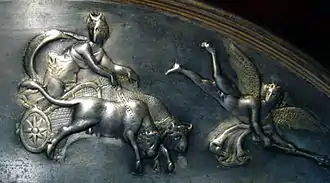
The Moon (![]() ) is the ruling planet of Cancer and is exalted in Taurus. In classical Roman mythology, the Moon was Luna, at times identified with Diana. The Moon is large enough for its gravity to affect the Earth, stabilizing its orbit and producing the regular ebb and flow of the tides. The lunar day syncs up with its orbit around Earth in such a manner that the same side of the Moon always faces the Earth and the other side, known as the "far side of the Moon" faces towards space.
) is the ruling planet of Cancer and is exalted in Taurus. In classical Roman mythology, the Moon was Luna, at times identified with Diana. The Moon is large enough for its gravity to affect the Earth, stabilizing its orbit and producing the regular ebb and flow of the tides. The lunar day syncs up with its orbit around Earth in such a manner that the same side of the Moon always faces the Earth and the other side, known as the "far side of the Moon" faces towards space.
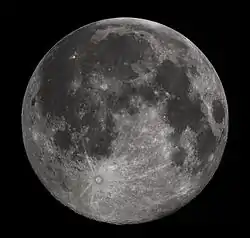
Astrologically speaking, the Moon is associated with a person's intuition, emotional make-up, unconscious habits, rhythms, memories, moods, femininity and their ability to react and adapt to those around them. It is associated for some with the mother, maternal instincts or the urge to nurture, the home, the need for security and the past, especially early experiences and childhood. The 1st-century poet Manilius described the Moon, or Luna, as melancholic. In medicine, the Moon is associated with the digestive system, stomach, breasts, the ovaries and menstruation (which occurs on a monthly cycle)[27] and the pancreas. Despite Manilius's assignment, the Moon is more commonly associated with the phlegmatic humor; it ruled the animal spirits. In modern astrology, the Moon is the primary native ruler of the fourth house, but traditionally it had its joy in the twelfth house.
The Moon or Luna is associated with Monday, the word Monday comes from the Old English word for Moon day or Moon's day, and in Romance languages, the name for Monday comes from luna (e.g., luni in Romanian, lundi in French, lunes in Spanish and lunedi in Italian). Dante Alighieri associated the Moon with the liberal art of grammar.
In Chinese astrology, the Moon represents Yin, the passive and receptive feminine life principle. In Indian astrology, the Moon is called Chandra or Soma and represents the mind, queenship and mother. The north lunar node (called Rahu) and the south lunar node (called Ketu) are considered to be of particular importance and are given an equal place alongside the seven classical planets as part of the nine navagraha.
The Muslim thinker Nasir Khusraw uses metaphors to the sun and the moon to explain complex esoteric doctrines. He likens the enunciator of divine revelation (nāṭiq) and the Imam to the Sun, whose brightness is succeeded by the Moon, likened to the foundation of esoteric interpretation (asās) and the proof (ḥujjat).[28]
Mercury

Mercury (![]() ) is the ruling planet of Gemini and Virgo and is exalted in Virgo. In classical Roman mythology, Mercury is the messenger of the gods, noted for his speed and swiftness. Echoing this, the scorching, airless world Mercury circles the Sun on the fastest orbit of any planet. Mercury takes only 88 days to orbit the Sun, spending about 7.33 days in each sign of the zodiac. Mercury is so close to the Sun that only a brief period exists after the Sun has set where it can be seen with the naked eye, before following the Sun beyond the horizon.[29]
) is the ruling planet of Gemini and Virgo and is exalted in Virgo. In classical Roman mythology, Mercury is the messenger of the gods, noted for his speed and swiftness. Echoing this, the scorching, airless world Mercury circles the Sun on the fastest orbit of any planet. Mercury takes only 88 days to orbit the Sun, spending about 7.33 days in each sign of the zodiac. Mercury is so close to the Sun that only a brief period exists after the Sun has set where it can be seen with the naked eye, before following the Sun beyond the horizon.[29]
Astrologically speaking, Mercury represents the principles of communication, mentality, thinking patterns, rationality and reasoning, and adaptability and variability. Mercury governs schooling and education, the immediate environment of neighbors, siblings and cousins, transport over short distances, messages and forms of communication such as post, email and telephone, newspapers, journalism and writing, information gathering skills and physical dexterity. The 1st-century poet Marcus Manilius described Mercury as an inconstant, vivacious and curious planet.

In medicine, Mercury is associated with the nervous system, the brain, the respiratory system, the thyroid and the sense organs. It is traditionally held to be essentially cold and dry, according to its placement in the zodiac and in any aspects to other planets.
In modern astrology, Mercury is regarded as the ruler of the third house; traditionally, it had the joy in the eleventh house. Mercury is the messenger of the gods in mythology. It is the planet of day-to-day expression and relationships. Mercury's action is to take things apart and put them back together again. It is an opportunistic planet, decidedly unemotional and curious.
Mercury rules over Wednesday. In Romance languages, the word for Wednesday is often similar to Mercury (miercuri in Romanian, mercredi in French, miercoles in Spanish and mercoledì in Italian). Dante Alighieri associated Mercury with the liberal art of dialectic.
In Chinese astrology Mercury represents Water, the fourth element, therefore symbolizing communication, intelligence, and elegance.
Venus

Venus (![]() ) is the traditional ruling planet of Libra and Taurus and is exalted in Pisces. In classical Roman mythology, Venus is the goddess of love and beauty, famous for the passions she could stir among the gods. Her cults may represent the religiously legitimate charm and seduction of the divine by mortals, in contrast to the formal, contractual relations between most members of Rome's official pantheon and the state, and the unofficial, illicit manipulation of divine forces through magic.
) is the traditional ruling planet of Libra and Taurus and is exalted in Pisces. In classical Roman mythology, Venus is the goddess of love and beauty, famous for the passions she could stir among the gods. Her cults may represent the religiously legitimate charm and seduction of the divine by mortals, in contrast to the formal, contractual relations between most members of Rome's official pantheon and the state, and the unofficial, illicit manipulation of divine forces through magic.
Venus orbits the Sun in 225 days, spending about 18.75 days in each sign of the zodiac. Venus is the second-brightest object in the night sky, the Moon being the brightest. It is usually beheld as a twin planet to Earth.
Astrologically speaking, Venus is associated with the principles of harmony, beauty, refinement, affections, love, and the urge to sympathize and unite with others. It is involved with the desire for pleasure, comfort and ease. It governs romantic relations, sex (the origin of the words 'venery' and 'venereal'), marriage and business partnerships, the arts, fashion and social life. The 1st-century poet Marcus Manilius described Venus as generous and fecund and the lesser benefic.
.jpg.webp)
The planet Venus in medicine is associated with the reproductive system, lumbar region, the veins, parathyroids, throat and kidneys. Venus was thought to be moderately warm and moist and associated with the phlegmatic humor.
Venus is the planet of Friday. In languages deriving from Latin, such as Romanian, Spanish, French, and Italian, the word for Friday often resembles the word Venus (vineri, viernes, vendredi and venerdì respectively). Dante Alighieri associated Venus with the liberal art of rhetoric.[30] In Chinese astrology, Venus is associated with the element metal, which is unyielding, strong and persistent. In Indian astrology, Venus is known as Shukra and represents wealth, pleasure and reproduction. In Norse Paganism, the planet is associated to Freyja, the goddess of love, beauty and fertility.[31]
Sun
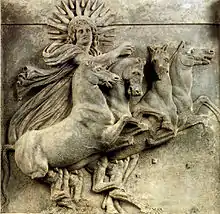
The Sun (![]() ) is the ruling planet of Leo and is exalted in Aries. In classical Greek mythology, the Sun was represented by the Titans Hyperion and Helios (Roman Sol, and later by Apollo, the god of light). The Sun is the star at the center of the Solar System, around which the Earth and other planets revolve and provides us with heat and light. The arc that the Sun travels in every year, rising and setting in a slightly different place each day, is therefore in reality a reflection of the Earth's own orbit around the Sun. This arc is larger the farther north or south from the equator latitude, giving a more extreme difference between day and night and between seasons during the year. The Sun travels through the twelve signs of the zodiac on its annual journey, spending about a month in each. The Sun's position on a person's birthday therefore determines what is usually called his or her "sun" sign. However, the sun sign allotment varies between Western (sign change around 22-23 of every month) and Hindu astrology (sign change around 14-15 of every month) due to the different systems of planetary calculations, following the tropical and sidereal definitions respectively.
) is the ruling planet of Leo and is exalted in Aries. In classical Greek mythology, the Sun was represented by the Titans Hyperion and Helios (Roman Sol, and later by Apollo, the god of light). The Sun is the star at the center of the Solar System, around which the Earth and other planets revolve and provides us with heat and light. The arc that the Sun travels in every year, rising and setting in a slightly different place each day, is therefore in reality a reflection of the Earth's own orbit around the Sun. This arc is larger the farther north or south from the equator latitude, giving a more extreme difference between day and night and between seasons during the year. The Sun travels through the twelve signs of the zodiac on its annual journey, spending about a month in each. The Sun's position on a person's birthday therefore determines what is usually called his or her "sun" sign. However, the sun sign allotment varies between Western (sign change around 22-23 of every month) and Hindu astrology (sign change around 14-15 of every month) due to the different systems of planetary calculations, following the tropical and sidereal definitions respectively.

Astrologically speaking, the Sun is usually thought to represent the conscious ego, the self and its expression, personal power, pride and authority, leadership qualities and the principles of creativity, spontaneity, health and vitality, the sum of which is named the "life force". One of the first recorded references to Sun worship is from the Mesopotamian Religion and described in the Epic of Gilgamesh. The 1st-century poet Marcus Manilius in his epic, 8000-verse poem, Astronomica, described the Sun, or Sol, as benign and favorable. In medicine, the Sun is associated with the heart, circulatory system,[32] and the thymus. Additionally, humans depend on the sun to produce and obtain vitamin D; an important supplement aiding the body's immune system and bone health. In Ayurveda, it rules over life-force (praan-shakti), governs bile temperament (pitta), stomach, bones and eyes. In modern astrology, the Sun is the primary native ruler of the fifth house, but traditionally it had its joy in the ninth house.
The Sun is associated with Sunday. Dante Alighieri associated the Sun with the liberal art of music. In Chinese astrology, the Sun represents Yang, the active, assertive masculine life principle.
The Muslim thinker Nasir Khusraw uses metaphors to the sun to explain complex esoteric doctrines. He likens the enunciator of divine revelation (nāṭiq) and the Imam to the Sun, whose brightness is succeeded by the Moon, likened to the foundation of esoteric interpretation (asās) and the proof (ḥujjat).[28]
Mars

Mars (![]() ) is the traditional ruling planet of Aries and Scorpio and is exalted in Capricorn. Mars is the Roman god of war and bloodshed, whose symbol is a spear and shield. Both the soil of Mars and the hemoglobin of human blood are rich in iron and because of this they share its distinct deep red color.[33] He was second in importance only to Jupiter and Saturn, due to Mars being the most prominent of the military gods worshipped by the Roman legions.
) is the traditional ruling planet of Aries and Scorpio and is exalted in Capricorn. Mars is the Roman god of war and bloodshed, whose symbol is a spear and shield. Both the soil of Mars and the hemoglobin of human blood are rich in iron and because of this they share its distinct deep red color.[33] He was second in importance only to Jupiter and Saturn, due to Mars being the most prominent of the military gods worshipped by the Roman legions.
Mars orbits the Sun in 687 days, spending about 57.25 days in each sign of the zodiac. It is also the first planet that orbits outside of Earth's orbit, making it the first planet that does not set along with the Sun. Mars has two permanent polar ice caps. During a pole's winter, it lies in continuous darkness, chilling the surface and causing the deposition of 25–30% of the atmosphere into slabs of CO2 ice (dry ice).
Astrologically speaking, Mars is associated with aggression, confrontation, energy, strength, ambition and impulsiveness. Mars governs sports, competitions and physical activities in general. The 1st-century poet Manilius, described the planet as ardent and as the lesser malefic. In medicine, Mars presides over the genitals, the muscular system, the gonads and adrenal glands. It was traditionally held to be hot and excessively dry and rules the choleric humor. It was associated with fever, accidents, trauma, pain and surgery.
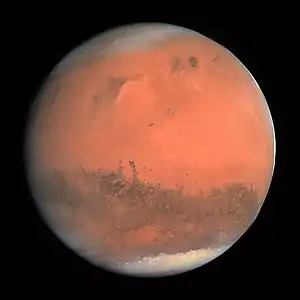
In modern astrology, Mars is the primary native ruler of the first house. Traditionally however, Mars ruled both the third and tenth houses, and had its joy in the fifth house. While Venus tends to the overall relationship atmosphere, Mars is the passionate impulse and action, the masculine aspect, discipline, willpower and stamina.
Mars is associated with Tuesday and in Romance languages the word for Tuesday often resembles Mars (in Romanian, marţi, in Spanish, martes, in French, mardi and in Italian "martedì"). The English "Tuesday" is a modernised form of "Tyr's Day", Tyr being the Germanic analogue to Mars. Dante Alighieri associated Mars with the liberal art of arithmetic. In Chinese astrology, Mars is ruled by the element fire, which is passionate, energetic and adventurous. In Indian astrology, Mars is called Mangala and represents energy, confidence and ego.
Jupiter

Jupiter (![]() ) is the traditional ruling planet of Sagittarius and Pisces and it is exalted in Cancer. In classical Roman mythology, Jupiter is the ruler of the gods and their guardian and protector, and his symbol is the thunderbolt. The Romans believed that Jupiter granted them supremacy because they had honored him more than any other people had. Jupiter was "the fount of the auspices upon which the relationship of the city with the gods rested." He personified the divine authority of Rome's highest offices, internal organization, and external relations. His image in the Republican and Imperial Capitol bore regalia associated with Rome's ancient kings and the highest consular and Imperial honours.
) is the traditional ruling planet of Sagittarius and Pisces and it is exalted in Cancer. In classical Roman mythology, Jupiter is the ruler of the gods and their guardian and protector, and his symbol is the thunderbolt. The Romans believed that Jupiter granted them supremacy because they had honored him more than any other people had. Jupiter was "the fount of the auspices upon which the relationship of the city with the gods rested." He personified the divine authority of Rome's highest offices, internal organization, and external relations. His image in the Republican and Imperial Capitol bore regalia associated with Rome's ancient kings and the highest consular and Imperial honours.
In the same way, the planet Jupiter is the king of the other planets, a giant in size with spectacular, brightly colored clouds and intense storms.[34] Some astronomers believe that it plays an important protecting role in using its massive gravity to capture or expel from the solar system many comets and asteroids that would otherwise threaten Earth and the inner planets.[35] Jupiter takes 11.9 years to orbit the Sun, spending almost an earth year (361 days) in each sign of the zodiac. Furthermore, Jupiter is usually the fourth-brightest object in the sky (after the Sun, the Moon and Venus).
Astrologically speaking, Jupiter is associated with the principles of growth, expansion, healing, prosperity, good fortune, and miracles. Jupiter governs long distance and foreign travel, big business and wealth, higher education, religion, and the law. It is also associated with the urge for freedom and exploration, as well with gambling and merrymaking.
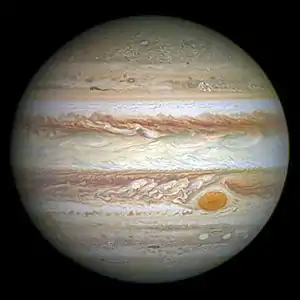
The 1st-century poet Manilius described Jupiter as temperate and benign, and the greater benefic. It was regarded as warm and moist in nature, and therefore favorable to life. In medicine, Jupiter is associated with the liver, pituitary gland, and the disposition of fats; it governs the sanguine humor. In modern astrology, Jupiter is the primary native ruler of the ninth house, but traditionally, Jupiter was assigned to both the second and ninth houses: the house of values and the house of beliefs, respectively, and had its joy in the second house of good luck.
Jupiter is associated with Thursday, and in Romance languages, the name for Thursday often comes from Jupiter (e.g., joi in Romanian, jeudi in French, jueves in Spanish, and giovedì in Italian). Dante Alighieri associated Jupiter with the liberal art of geometry. In Chinese astrology, Jupiter is ruled by the element wood, which is patient, hard-working, and reliable. In Indian astrology, Jupiter is known as Guru or Brihaspati and is known as the 'great teacher'. [36]
Saturn
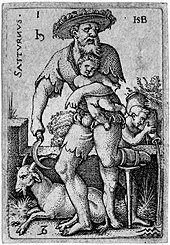
Saturn (![]() ) is the traditional ruling planet of Capricorn and Aquarius and is exalted in Libra. In classical Roman mythology, Saturn is the god of seeds, crops, and the harvest (agriculture), leader of the titans, father and founder of civilizations, social order, and conformity. The glyph is shaped like a scythe, but it is known as the "crescent below the cross", whereas Jupiter's glyph is the "crescent above the cross". Famous rings of the planet Saturn that enclose and surround it, reflect the idea of human limits. Saturn takes 29.5 years to orbit the Sun, spending about 2.46 years in each sign of the zodiac. During ancient Roman society, the Romans worshipped Saturn as the highest ranking and most important god among their pantheon of deities, sharing that same prestige with Jupiter.
) is the traditional ruling planet of Capricorn and Aquarius and is exalted in Libra. In classical Roman mythology, Saturn is the god of seeds, crops, and the harvest (agriculture), leader of the titans, father and founder of civilizations, social order, and conformity. The glyph is shaped like a scythe, but it is known as the "crescent below the cross", whereas Jupiter's glyph is the "crescent above the cross". Famous rings of the planet Saturn that enclose and surround it, reflect the idea of human limits. Saturn takes 29.5 years to orbit the Sun, spending about 2.46 years in each sign of the zodiac. During ancient Roman society, the Romans worshipped Saturn as the highest ranking and most important god among their pantheon of deities, sharing that same prestige with Jupiter.
Astrologically speaking, Saturn is associated with focus, precision, nobility, ethics, civility, lofty goals, career, great achievements, dedication, authority figures, stability, virtues, productiveness, valuable hard lessons learned, destiny, structures, protective roles, balance, conservation, and karma (reaping what you have sown or cosmic justice) but with limitations, restrictions, boundaries, anxiety, tests, practicality, reality, and time. It concerns a person's sense of duty, commitment, responsibility, including their physical and emotional endurance in times of hardships. Saturn is fundamentally economical. It also represents concern with long-term planning or foresight. The Return of Saturn is said to mark significant events in each person's life. According to the 1st-century poet Manilius, Saturn is sad, morose, and cold, and is the greater malefic. Claudius Ptolemy states that "Saturn is lord of the right ear, the spleen, the bladder, the phlegm, and the bones."[37] Saturn symbolized processes and things that were dry and cold, which are necessary balancing aspects to maintain life. It governs the melancholic humor.
According to Sefer Yetzirah – GRA Version – Kaplan 4:13[38]
"He made the letter Resh king over Peace
And He bound a crown to it
And He combined one with another
And with them He formed
Saturn in the Universe
Friday in the Year
The left nostril in the Soul,
male and female."
.jpg.webp)
Before the discovery of Uranus, Saturn was regarded as the ruling planet of Aquarius alongside Capricorn of course, which is the preceding sign. In traditional Western astrology, it is the primary native ruler of the tenth house. In traditional Hindu astrology however, Saturn ruled both the first and eighth houses, and had its joy in the twelfth house of mischief and bad luck.
Saturn is associated with Saturday, which was named after the deity Saturn. Dante Alighieri associated Saturn with the liberal art of astronomia (astronomy and astrology).
In Chinese astrology, Saturn is ruled by the element earth, which is warm, generous, and co-operative. In Indian astrology, Saturn is called Shani or "Sani", representing a noteworthy career and longevity. He is also the bringer of obstacles and hardship.[39]
Modern planets
Since the invention of the telescope, Western astrology has incorporated Uranus, Neptune, Ceres, Pluto, and other bodies into its methodology. The Indian and Chinese astrologies have tended to retain the ancient seven-planet system. Meanings have had to be assigned to them by modern astrologers, usually according to the major events that occurred in the world at the time of their discovery. As these astrologers are usually Western, the social and historical events they describe have an inevitable Western emphasis. Astrologers consider the "extra-Saturnian" planets to be "impersonal" or generational planets, meaning their effects are felt more across whole generations of society. Their effects in individuals depend upon how strongly they feature in that individual's birth-chart. The following are their characteristics as accepted by most astrologers.[40]
Uranus
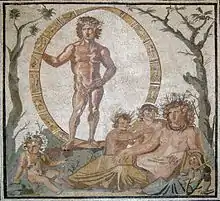
Uranus (![]() ) is the modern ruling planet of Aquarius and is exalted in Scorpio. In classical Greek mythology, Uranus is the personification of the sky. The planet Uranus is very unusual among the planets in that it rotates on its side, so that it presents each of its poles to the Sun in turn during its orbit; causing both hemispheres to alternate between being bathed in light and lying in total darkness over the course of the orbit.
) is the modern ruling planet of Aquarius and is exalted in Scorpio. In classical Greek mythology, Uranus is the personification of the sky. The planet Uranus is very unusual among the planets in that it rotates on its side, so that it presents each of its poles to the Sun in turn during its orbit; causing both hemispheres to alternate between being bathed in light and lying in total darkness over the course of the orbit.
Uranus takes 84 years to orbit the Sun, spending about seven years in each sign of the zodiac. Uranus was discovered to be a planet only in 1781 by Sir William Herschel.
Astrological interpretations associate Uranus with the principles of ingenuity, new or unconventional ideas, individuality, discoveries, electricity, inventions, democracy, and revolutions. Uranus, among all planets, most governs genius.

Uranus governs societies, clubs, and any group based on humanitarian or progressive ideals. Uranus, the planet of sudden and unexpected changes, rules freedom and originality. In society, it rules radical ideas and people, as well as revolutionary events that upset established structures. Uranus is also associated with Wednesday, alongside Mercury (since Uranus is in the higher octave of Mercury).
In art and literature, the discovery of Uranus coincided with the Romantic movement, which emphasized individuality and freedom of creative expression. Additionally, it is often linked to an individual's animal spirit. When it comes to medicine, Uranus is believed to be particularly associated with the sympathetic nervous system, mental disorders, breakdowns and hysteria, spasms, and cramps. Uranus is considered by modern astrologers to be the primary native ruler of the eleventh house.[41]
Neptune
Neptune (![]() ) is the modern ruling planet of Pisces and is exalted in Cancer and Leo. In classical Roman mythology, Neptune is the god of the sea, and the deep, ocean blue color of the planet Neptune reflects this.[42] Its glyph is taken directly from Neptune's trident, symbolizing the curve of spirit being pierced by the cross of matter. Neptune takes 165 years to orbit the Sun, spending approximately 14 years (13.75) in each sign of the zodiac.[43] Neptune was discovered in 1846.
) is the modern ruling planet of Pisces and is exalted in Cancer and Leo. In classical Roman mythology, Neptune is the god of the sea, and the deep, ocean blue color of the planet Neptune reflects this.[42] Its glyph is taken directly from Neptune's trident, symbolizing the curve of spirit being pierced by the cross of matter. Neptune takes 165 years to orbit the Sun, spending approximately 14 years (13.75) in each sign of the zodiac.[43] Neptune was discovered in 1846.
_flatten_crop.jpg.webp)
Astrologically speaking, Neptune is associated with the collective consciousness, idealism, dreams/fantasy, projections, undoing/dissolution of the status quo, evolutions, artistry, empathy, and illusion/confusion/vagueness on the way to discovering universal truths.[44]

Like with Venus, the planet Neptune is also associated with Friday because Neptune is the higher octave of Venus. In art, the impressionist movement began a trend away from literal representation, to one based on the subtle, changing moods of light and color. In medicine, Neptune is seen to be particularly associated with the thalamus, the spinal canal, and uncertain illnesses or neuroses. Neptune is considered by modern astrologers to be the primary ruler of the twelfth house.
Pluto
Pluto (![]() ) is the modern ruling planet of Scorpio and is exalted in Leo. In classical Roman mythology, Pluto is the god of the underworld who is extremely wealthy. The alchemical symbol was given to Pluto on its discovery, three centuries after alchemical practices had all but disappeared. The alchemical symbol can therefore be read as spirit over mind, transcending matter.
) is the modern ruling planet of Scorpio and is exalted in Leo. In classical Roman mythology, Pluto is the god of the underworld who is extremely wealthy. The alchemical symbol was given to Pluto on its discovery, three centuries after alchemical practices had all but disappeared. The alchemical symbol can therefore be read as spirit over mind, transcending matter.
Pluto takes 248 years to make a full circuit of the zodiac, but its progress is highly variable: it spends between 15 and 26 years in each sign.
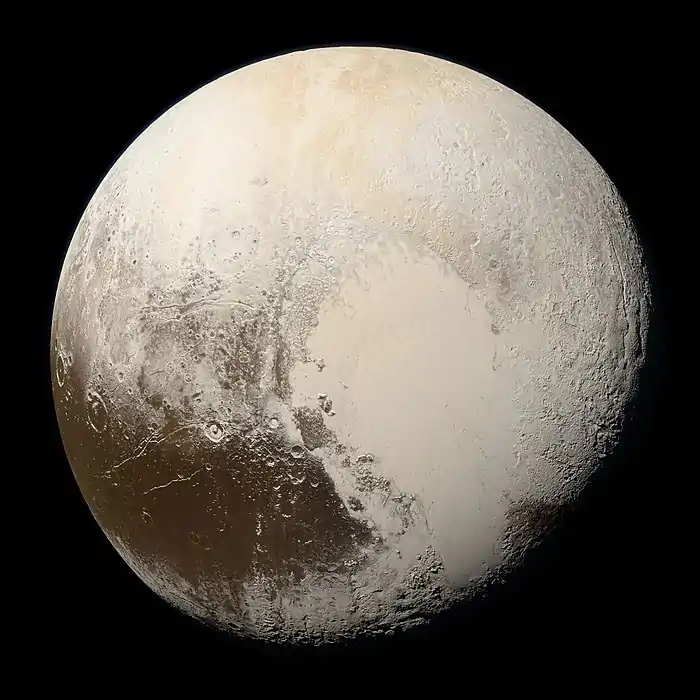
Astrologically speaking, Pluto is called "the great renewer" and is considered to represent the part of a person that destroys in order to renew by bringing up buried intense needs and drives to the surface, and expressing them, even at the expense of the existing order. A commonly used keyword for Pluto is "transformation".[46] It is associated with absolutes, power, extremities, transformations, incredible feats, mass movements, and the need to cooperate or share with another if each is not to be destroyed.[47] Pluto governs major business and enormous wealth, mining, surgery and detective work, and any enterprise that involves digging under the surface to bring the truth to light. Pluto is also associated with Tuesday, alongside Mars since Pluto is the higher octave of that planet in astrology.
Its entry in Cancer in 1914, the sign in which it was later discovered, coincided with World War I. It is also associated with nuclear armament due to such weapons using plutonium, which was named after the dwarf planet. Nuclear research had its genesis in the 1930s and 40s and later gave rise to the polarized nuclear standoff of the Cold War, with the mass consumer societies of the United States and other democracies facing the totalitarian state of the USSR. The discovery of Pluto also occurred just after the birth of modern psychoanalysis, when Freud and Jung began to explore the depths of the unconscious.
In real life events and culture, Pluto has been a major astrological aspect. When it comes to art, movements like Cubism and Surrealism began to de-construct the "normal" view of the world. In medicine, Pluto is seen to be associated with regenerative forces in the body involving cell formation and the reproductive system.[46] The majority of traditional astrologers do not use Pluto as a ruling planet, but do use the planet for interpretation and predictive work, obliquely making reference to projections of influences from higher to lower dimensional spaces.[46] Pluto is considered by modern astrologers to be the primary native ruler of the eighth house and a higher octave of Mars that functions on a collective level.
Ceres
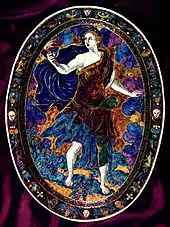
Ceres (![]() ) is the smallest identified dwarf planet in the Solar System, but is significantly the largest object in the asteroid belt. It was discovered on 1 January 1801 by Giuseppe Piazzi, and is named after Ceres, the Roman goddess of growing plants, the harvest, and of motherly love. It was the first asteroid discovered, taking up about one-third of the entire mass of its asteroid belt.[48] The classification of Ceres has changed more than once and has been the subject of some disagreement.[49] Johann Elert Bode believed Ceres to be the "missing planet" he had proposed to exist between Mars and Jupiter, at a distance of 419 million km (2.8 AU) from the Sun. Ceres was assigned a planetary symbol, and remained listed as a planet in astronomy books and tables for about half a century. The 2006 debate surrounding Pluto and what constitutes a planet led to Ceres being considered for reclassification as a planet, but in the end, Ceres and Pluto were classified as the first members of the new dwarf planet category.
) is the smallest identified dwarf planet in the Solar System, but is significantly the largest object in the asteroid belt. It was discovered on 1 January 1801 by Giuseppe Piazzi, and is named after Ceres, the Roman goddess of growing plants, the harvest, and of motherly love. It was the first asteroid discovered, taking up about one-third of the entire mass of its asteroid belt.[48] The classification of Ceres has changed more than once and has been the subject of some disagreement.[49] Johann Elert Bode believed Ceres to be the "missing planet" he had proposed to exist between Mars and Jupiter, at a distance of 419 million km (2.8 AU) from the Sun. Ceres was assigned a planetary symbol, and remained listed as a planet in astronomy books and tables for about half a century. The 2006 debate surrounding Pluto and what constitutes a planet led to Ceres being considered for reclassification as a planet, but in the end, Ceres and Pluto were classified as the first members of the new dwarf planet category.
Ceres passes through the zodiac every 4 years and 7 months, passing through a little more than 2½ signs every year.
In mythology, Ceres is the Roman equivalent of the Greek goddess Demeter, and is the goddess of agriculture. The goddess (and metaphorically the planet) is also associated with the reproductive issues of an adult woman, as well as pregnancy and other major transitions in a woman's life, including the nine months of gestation time, family bonds and relationships. In the early 1800s after its discovery, , Ceres was seen as the ruling planet of Virgo. Due to its mythological connection to the harvest cycle, some modern astrologers feel Ceres should be the ruler of Taurus, however, many European astrologers see Ceres as ruling Virgo with its observed connection to the practical, being of service and assisting.[50] Although a mother, Ceres is also the archetype of a virgin goddess which is associated with Virgo. Ceres may be epitomized by independent women who are often unmarried (since, according to myth, Ceres is an unmarried goddess who chose to become a mother without a husband or partner.) While the moon represents our ideal of "motherhood", Ceres would represent how our real and natural motherhood should be.[51] In point of fact, Ceres is often observed in strong aspect in the synastry of parents and children as well as marriage partners' charts.
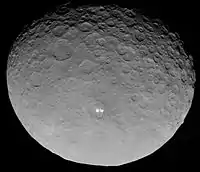
Ceres, as the Goddess who has control over nature's resources and cycles, may astrologically be considered the planet of the Environment. Returning to mythology, an early environmental villain is the figure of Erysichthon, the tearer up of the earth, who cut down trees in a grove sacred to Ceres-Demeter, for which he was punished by the goddess with fearful hunger. In this sense, Ceres became an emerging archetype in the awareness of climate change in the 21st century and is entering the collective consciousness as a need to take care of our natural and irreplaceable resources. Ceres represents a leap towards a future of ecological responsibility and knowledge. As an indicator for environmental or community activism, Ceres would represent for some astrologers the wave of the future.[52]
Other Solar System bodies
Some asteroids such as Pallas (![]() ) and Vesta (
) and Vesta (![]() ), as well as dwarf planet Ceres, can sometimes be seen with binoculars (Vesta even with the naked eye), but these were not recognized as planetary, and perhaps not even noticed, until the early 19th century. In the early 19th century, Ceres, Juno (
), as well as dwarf planet Ceres, can sometimes be seen with binoculars (Vesta even with the naked eye), but these were not recognized as planetary, and perhaps not even noticed, until the early 19th century. In the early 19th century, Ceres, Juno (![]() ), and the other two aforementioned asteroids were for a time regarded as planets. Although asteroids have been known to both astronomers and astrologers for more than 200 years, they are often ignored by astrologers. The tradition of some astrologers casting charts with minor planets originates with these asteroids. Since the discovery of Chiron (
), and the other two aforementioned asteroids were for a time regarded as planets. Although asteroids have been known to both astronomers and astrologers for more than 200 years, they are often ignored by astrologers. The tradition of some astrologers casting charts with minor planets originates with these asteroids. Since the discovery of Chiron (![]() ) in the 1970s, some astrologers have been casting the new "planet", although astronomers consider it a centaur (a kind of intermediate object between comet and asteroid).[53]
) in the 1970s, some astrologers have been casting the new "planet", although astronomers consider it a centaur (a kind of intermediate object between comet and asteroid).[53]
In the 21st century, several new planet-sized bodies, including Sedna, Quaoar, Haumea, and Eris, have been discovered, but not yet incorporated into mainstream astrological predictions, although some more avant-garde groups have attempted to incorporate them.[54][55]
Comets and novae have been observed and discussed for several thousand years. Comets in particular were portents of great interest to ancient people and given various astrological interpretations. Both are erratic phenomena, and are rarely visible to the naked-eye; they are ignored by most modern astrologers.
Hypothetical planets
Some astrologers have hypothesized about the existence of unseen or undiscovered planets. In 1918, astrologer Sepharial proposed the existence of Earth's "Dark Moon" Lilith, and since then, some astrologers have been using it in their charts; though the same name is also (and now, more commonly) used in astrology to refer to the axis of the actual Moon's orbit. The 20th-century German school of astrology known as Uranian astrology also claimed that many undiscovered planets existed beyond the orbit of Neptune, giving them names such as Cupido, Hades, Zeus, Kronos, Apollon, Admetos, Vulcanus, and Poseidon, and charting their supposed orbits. These orbits have not coincided, however, with more recent discoveries by astronomers of objects beyond Neptune and scientific hypotheses.
Other astrologers have focused on the theory that in time, all twelve signs of the zodiac will each have their own ruler, so that another two planets have yet to be discovered; namely the "true" rulers of Taurus and Virgo. The names of the planets mentioned in this regard by some are Vulcan (ruler of Virgo) and Apollo, the Roman god of the Sun (ruler of Taurus).[56] Another version of this theory states that the modern planets discovered so far correspond to the elements known to the ancients—air (Uranus, god of the heavens), water (Neptune, god of the sea), and fire (Pluto, god of the underworld)—which leaves the elements earth and ether (the fifth element of the fiery upper air). In other words, it is claimed that the two planets to be discovered will be named after an earth god or goddess (such as Persephone, the Horae, Gaia, or Antu), and after Aether, the Roman and Greek god of the upper air and stars.

Ruling planets of the astrological signs and houses
In Western astrology, the symbolism associated with the planets also relates to the zodiac signs and houses of the horoscope in their various rulerships. For instance, the description of Mars is masculine, impulsive, and active. Aries is ruled by Mars and has a similar description, representing an active, masculine archetype. Similarly, the first house is also ruled by Mars, and deals with a person's physical health and strength, and the manner in which they project themselves.
Table 1: Modern signs, houses and planetary associations
| Sign | House | Domicile | Detriment | Exaltation | Fall | Planetary Joy |
|---|---|---|---|---|---|---|
| Aries | 1st House | Mars | Venus | Sun | Saturn | Pluto |
| Taurus | 2nd House | Venus, | Pluto | Moon | Uranus | Jupiter |
| Gemini | 3rd House | Mercury | Jupiter | N/A | N/A | Uranus |
| Cancer | 4th House | Moon | Saturn | Jupiter | Mars | Venus |
| Leo | 5th House | Sun | Uranus | Neptune | Mercury | Mars |
| Virgo | 6th House | Chiron, Mercury | Neptune | Pluto, Mercury | Venus | Saturn |
| Libra | 7th House | Venus | Mars | Saturn | Sun | Neptune |
| Scorpio | 8th House | Pluto | Venus | Uranus | Moon | Saturn |
| Sagittarius | 9th House | Jupiter | Mercury | Chiron | Ceres | Sun |
| Capricorn | 10th House | Saturn | Moon | Mars | Jupiter | Pluto |
| Aquarius | 11th House | Uranus | Sun | Mercury | Neptune | Mercury |
| Pisces | 12th House | Neptune | Ceres, Mercury | Venus | Pluto, Mercury | Moon |
Note: The planets in the table rule the signs on the same row, and the houses do correspond with the signs on the same row (i.e. Mars rules Aries; Aries and first house share some correspondences). However, it is only modern astrology that links the planets to the houses in this order.[57] The bulk of the tradition assigns planetary rulerships according to the ancient Chaldean astronomical order of the planets (Saturn, Jupiter, Mars, Sun, Venus, Mercury, Moon; the former order of the planets in distance from Earth geocentrically):
Table 2: Traditional Chaldean houses and planetary relationships.
| House | Traditional Ruling planet | Planetary Joy |
|---|---|---|
| 1st House | Saturn | Mercury |
| 2nd House | Jupiter | N/A |
| 3rd House | Mars | Moon |
| 4th House | Sun | N/A |
| 5th House | Venus | Venus |
| 6th House | Mercury | Mars |
| 7th House | Moon | N/A |
| 8th House | Saturn | N/A |
| 9th House | Jupiter | Sun |
| 10th House | Mars | N/A |
| 11th House | Sun | Jupiter |
| 12th House | Venus | Saturn |
Notes
- Hone (1978), p.22
- Hone (1978) p. 19
- Arroyo (1989) pp. 7, 27
- Hone (1978), p.19 8th paragraph
- Copenhaver, Brian P. (1992) Hermetica: The Greek Corpus Hermeticum and the Latin Asclepius in a New English Translation with Notes and Introduction, Cambridge University Press: New York, NY.
- http://spokensanskrit.de/index.php?tinput=budha&direction=SE&script=HK&link=yes
- http://www.behindthename.com/name/venus
- http://www.etymonline.com/index.php?term=Demeter
- Doric dā, Proto-Greek *dē, "earth" + mētēr, "mother". The dā element is not so simply equated with "earth" according to John Chadwick (Chadwick, The Mycenaean World [Cambridge University Press] 1976, p. 87): "Every Greek was aware of the maternal functions of Demeter; if her name bore the slightest resemblance to the Greek word for 'mother', it would inevitably have been deformed to emphasize that resemblance. [...] How did it escape transformation into *Gāmātēr, a name transparent to any Greek speaker?" Compare the Latin transformation Iuppiter and Diespiter vis-a-vis *Deus pāter.
- Monier-Williams, also "he is the chief offerer of prayers and sacrifices, and therefore represented as the type of the priestly order, and the Purohita of the gods with whom he intercedes for men."
- http://spokensanskrit.de/index.php?tinput=vaasuki&direction=SE&script=HK&link=yes
- http://spokensanskrit.de/index.php?script=HK&tinput=Varuna&country_ID=&trans=Translate&direction=AU
- All speeds taken from StarFisher
- With the exceptions of the Sun and the Moon, all planets are capable of turning into retrograde motion and temporarily appearing to not move at all, this is not what lowest speed refers to in this case. "Lowest speed" in the section refers to the fastest speed a planet may move at when retrograde, reversing its progress.
- Darmstadt Hs. 266
- Blockbuch Basel AN V 37a
- Thott 290.2 (1459)
- Wolfegg Hausbuch (c. 1470)
- CGM 558 (c. 1490)
- Fuchs, B.A. (1909). Die Ikonographie der sieben Planeten in der Kunst Italiens bis zum Ausgang des Mittelalters [The iconography of the seven planets in the art of the Italians through the end of the middle ages] (Thesis). Munich.
- Panofsky, E.; Saxl, F. (1990). Saturn und Melancholie. Frankfurt.
- Graves, Robert (1955). The Greek Myths. England.
- Hauber, A. (1916). Planetenkinderbilder und Sternbilder. Straßburg.
- Baer, E. (1968). "Representations of "planet-children" in Turkish manuscripts". Bulletin of the School of Oriental and African Studies. 31 (3): 526–533. doi:10.1017/S0041977X00125546.
- Michael Meyer at khaldea.com, Rob Hand "Horoscope Symbols"
- Jeff Mayo, Teach Yourself Astrology, pp. 17–28, Hodder and Stoughton, London, 1964; Sasha Fenton Understanding Astrology, pp. 106–112, The Aquarian Press (Harper Collins), London, 1991; Derek and Julia Parker, The New Compleat Astrologer, pp. 86–99, Crescent Books, New York, 1971; Maritha Pottinger Astro Essentials, pp. 11–14, 17–18, ACS Publications, San Diego, 1991
- Back de Sarany, Géza Ibid., 37.
- Virani, Shafique. "The Days of Creation in the Thought of Nasir Khusraw". Nasir Khusraw: Yesterday, Today, Tomorrow.
- https://theastrocodex.com/2017/07/20/mercury-rulership-exaltation-detriment-fall/
- New Yorker, 20 May 2013.
- https://theastrocodex.com/2017/08/01/venus-rulership-exaltation-detriment-fall/
- Back de Surany, Géza. Manual de Astrología Médica. Índigo.1988. 214 páginas, p. 32
- Henbest, ibid
- Ingersoll, A. P.; Dowling, T. E.; Gierasch, P. J.; Orton, G. S.; et al. "Dynamics of Jupiter's Atmosphere" (PDF). Lunar & Planetary Institute. Retrieved 1 February 2007.
- George W. Wetherill (1994). "Possible consequences of absence of "Jupiters" in planetary systems". Astrophysics and Space Science. 212 (1–2): 23–32. Bibcode:1994Ap&SS.212...23W. doi:10.1007/BF00984505. PMID 11539457. S2CID 21928486.
- 1952-, Dalal, Roshen (2010). Hinduism : an alphabetical guide. New Delhi: Penguin Books. ISBN 9780143414216. OCLC 664683680.CS1 maint: numeric names: authors list (link)
- .html Tetrabiblos by Claudius Ptolemy published in the Loeb Classical Library, 1940
- "Sepher Yetzirah – Book of Formation (Saadia Version)". Hermetik International. Retrieved 28 September 2019.
- "Capricorn Trait - A zodiac sign ruled by Saturn". My Horoscope. Retrieved 24 January 2020.
- Jeff Mayo, Ibid, pp. 28–33, 1964; Sasha Fenton Ibid, pp. 112–115, 1991; Derek and Julia Parker, Ibid, pp. 100–105, 1971; Maritha Pottinger Ibid, pp. 15–19, 1991
- https://theastrocodex.com/2017/08/02/uranus-astrology/
- Julian Ting (2014). Rational Astrology, Julian Ting - Amazon.com. p. 144.
- Julian J.-L. Ting (2013). classical mechanics: Julian J.-L. Ting: Amazon.com Books. CreateSpace Independent Publishing Platform; 2nd edition (25 November 2013). p. 384. ISBN 978-1494279295.
- "Neptune: Planet of Illusion". ASTROLOGY.COM. 24 November 2009. Retrieved 29 July 2016.
- Creighton Gilbert, Caravaggio and His Two Cardinals (Penn State University Press, 1995), pp. 124–125.
- https://theastrocodex.com/2017/08/02/pluto-astrology/
- http://astrologyclub.org/pluto-control-vs-empowerment/
- E. V. Pitjeva, "Precise determination of the motion of planets and some astronomical constants from modern observations", 2004 International Astronomical Union, http://journals.cambridge.org/production/action/cjoGetFulltext?fulltextid=303499
- http://astrologyclub.org/asteroid-ceres/
- http://pandoraastrology.com/blog/ceres-rules-taurus
- Martin, Helena Planets in the astrological universe (los planetas en el universo astrológico), pp. 333–334, Ed. Indigo, Barcelona, 1990
- http://www.astrostar.com/articles/Ceres.htm
- "Chiron". Astrology-Numerology. Archived from the original on 19 November 2010. Retrieved 2 February 2011.
- "New Planets". Richard Brown. Astrology.
- "Sedna, Eris, Haumea, Quaoar, Makemake, 2002 TC302, Orcus, and others". AstroTransits.blogspot.com. New dwarf planets in Astrology.
- Linda Goodman, Sun Signs, p226, Pan Books, London, 1982
- http://theastrologypodcast.com/2014/06/10/rationale-significations-houses/
References
- Arroyo, Stephen (1989). Chart Interpretation Handbook. California: CCRS Publications.
- Hone, Margaret (1978). The Modern Text-Book of Astrology. Revised edition. England: L. N. Fowler & Co. Ltd.
- Houlding, D (2006). The Houses – Temples of the Sky The Wessex Astrologer, Bournemouth, England.
- Ptolemy, C.trans Ashmand, J. (2002). Tetrabiblos Astrology Classics, Maryland, USA.
External links
| Look up πλανήτης in Wiktionary, the free dictionary. |
- Astrolibrary.org: Birth Chart Interpretations
- New planets won't affect Vedic astrology (Anubha Sawhney). The Times of India, 18 August 2006, 02:13 am
- Redefining the stars, one planet at a time Houston Chronicle: (JEANNIE KEVER) 17 August 2006, 11:36 am
- Pluto Dissed: What Now for Astrologers? (Lynn Hayes) National Ledger: 25 August 2006
- (in English and Latin) Flowers of Abu Ma'shar, by 8th century Arabic astrology Ja‘far ibn Muḥammad al-Balkhī, discusses and depicts the planets and their role in astrology. This translation, in Latin, is by John of Seville.
